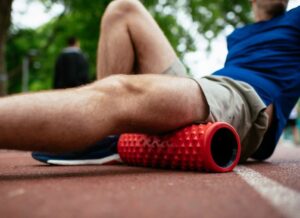Menu
Menu
Foam rolling has grown very popular over the last few years as an at-home remedy for alleviating muscle tension and discomfort all over the body. People all over the country use foam rolling after workouts to help recovery. Some people use foam rolling before a workout to warm up. Some people use foam rolling to get some relief from sitting or standing during their workday. The foam roller is in almost every single manual therapy clinic in America; physical therapy, chiropractors, massage therapy, and the acupuncturist will have a foam roller in their clinic. What most people don’t know is that there actually are some techniques and specific ways to foam roll that can be more or less advantageous for you depending on what you are trying to accomplish with the foam roller. This article will break down a few tips and tricks for you to get the most out of your foam rolling session.
 This portion of this article is going to be geared towards someone who is using the foam roller to warm up for any sort of activity; walking, running, hiking, lifting weights, playing tennis, hitting the driving range or any sort of activity where loosening up beforehand would be desirable.
This portion of this article is going to be geared towards someone who is using the foam roller to warm up for any sort of activity; walking, running, hiking, lifting weights, playing tennis, hitting the driving range or any sort of activity where loosening up beforehand would be desirable.
1. Start With A Firm Base: Make sure you are in a good position. Usually best to start on the ground, where there is firm support underneath you. You want to avoid trying foam rolling on a mattress or couch. You won’t get any results.
2. Prioritize One Area at a Time: Instead of rolling all over your body at once, focus on one area at a time, spending around 30 seconds to 2 minutes on each area. This will help you target specific areas that need attention.
3. Activate The Muscle Fibers: If the goal is to warm up before a workout, you will want to activate the muscle fibers to get the most out of your workout. Think of it like priming an engine. In order to ensure activation of the tissues you’re foam rolling, move throughout the desired area with a little bit of pace, moving back and forth. Not rushing frantically but moving with a steady and consistent pace. This will ensure the fibers are activated rather than relaxed when foam rolling.
4. Breathe: It’s important to breathe deeply and rhythmically, while foam rolling helps relax your muscles and promote blood flow. Focus on breathing in slowly through your nose and exhaling slowly through your mouth.
5. Finishing Up: The total duration spent on foam rolling is up to the user. We recommend spending about 30 seconds to 2 minutes on each area you are trying to target to warm up.
 1. Start With A Firm Base: Make sure you are in a good position. Usually best to start on the ground, where there is firm support underneath you. You want to avoid trying foam rolling on a mattress or couch. You won’t get any results.
1. Start With A Firm Base: Make sure you are in a good position. Usually best to start on the ground, where there is firm support underneath you. You want to avoid trying foam rolling on a mattress or couch. You won’t get any results.
2. Prioritize One Area at a Time: Instead of rolling all over your body at once, focus on one area at a time, spending around 30 seconds to 2 minutes on each area. This will help you target specific areas that need attention.
3. Relax The Tissue: To relax the tissue, you want to have very slow movements over the foam roller. You want to sometimes not even move at all. Find a spot you want to release, and just let the foam roller sit on that spot without moving. Moving slowly and under control will ensure that your muscle fibers are calming down rather than getting primed for exercise or movements.
4. When Would I Use This Style?: This style of foam rolling is great after a workout, before getting into bed for the night to sleep, after a long day sitting at the desk, or even after going on a walk or competing in some form of exercise. Anytime you want to try and relax the tissue.
5. Breathe: It’s important to breathe deeply and rhythmically, while foam rolling helps relax your muscles and promote blood flow. Focus on breathing in slowly through your nose and exhaling slowly through your mouth.
6. Finishing Up: The total duration spent on foam rolling is up to the user. We recommend spending about 30 seconds to 2 minutes on each area you are trying to target to warm up.
1. Foam Rolling On Top Of Bones or Joints: Do not, I repeat, do not foam roll directly on top of bones or joints. This will only cause pain and discomfort. Just don’t do it. Always be sure to foam roll on top of soft tissues, aka muscles.
2. Lacrosse Balls, Tennis Balls, or Other Release Tools: You can honestly use whatever you want to foam roll. From lacrosse balls to a golf balls, it’s all fair game. Just be aware that the firmer the ball or object you use to foam roll, generally the more painful it will be when trying to foam roll. Be nice. Start with a soft foam roller.
Foam rolling can be a highly effective technique for reducing muscle tension and promoting flexibility. However, it’s important to know why you are foam rolling and then apply these general tips for better results. Have fun!